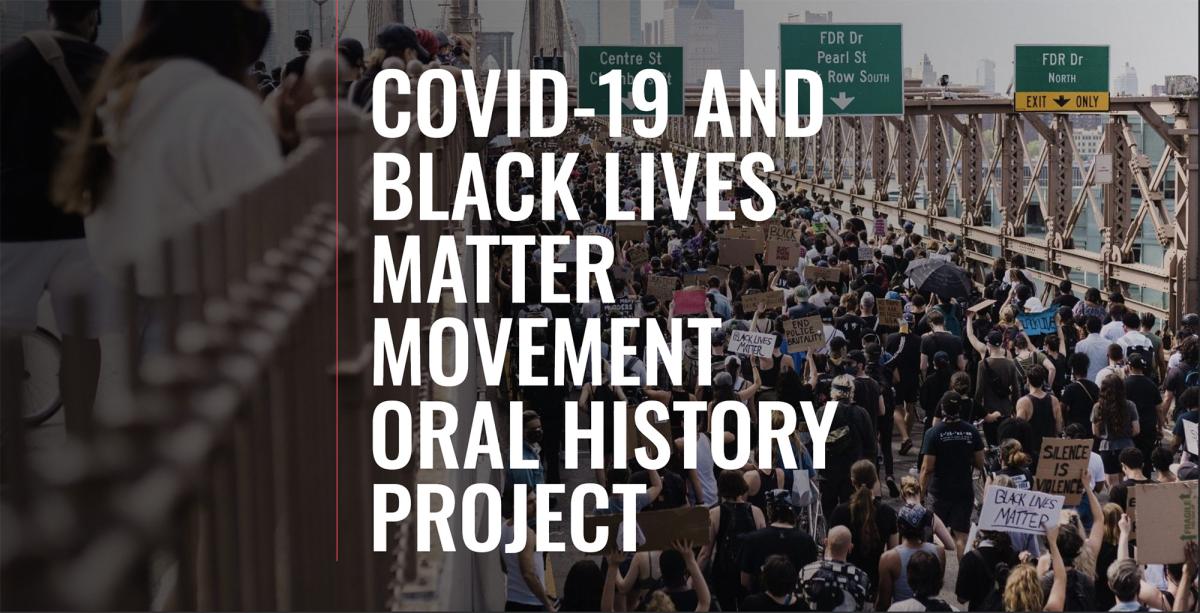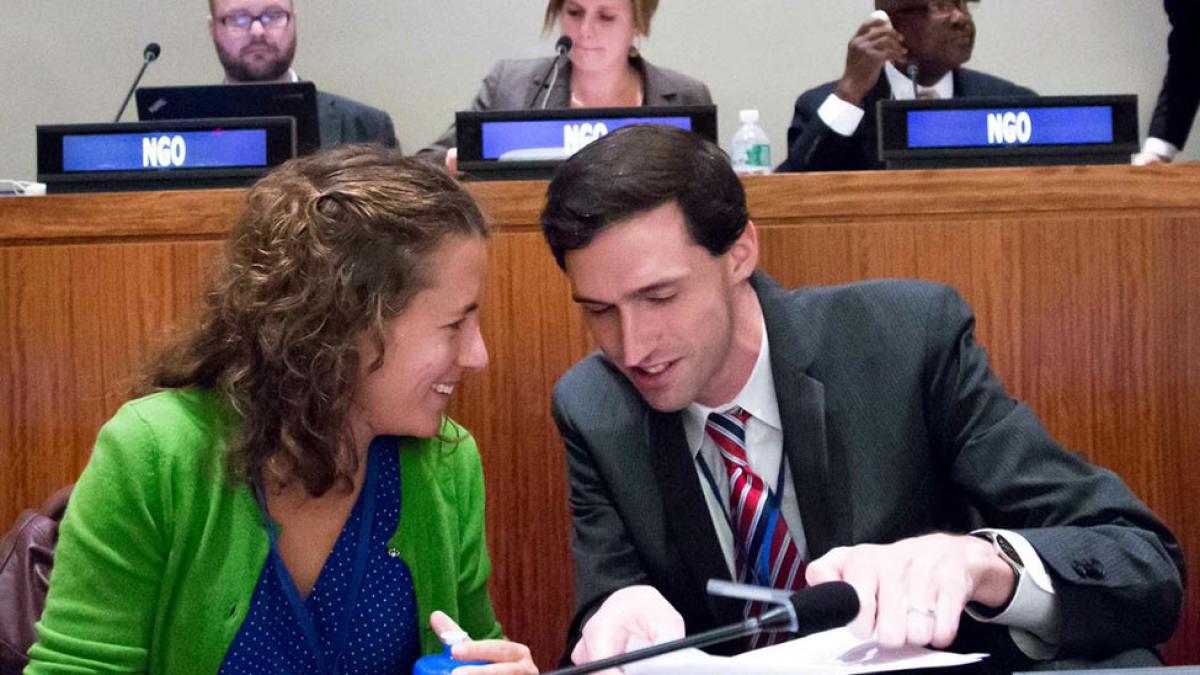
Hands-On Humanities: Experiential Learning in Unexpected Places
Thinking about studying the humanities may conjure images of dusty textbooks and snoozy lectures. In the Dyson College of Arts and Sciences, however, hands-on learning isn’t reserved solely for the science labs and art studios. In fact, Pace’s experiential approach to the humanities, particularly in the English department, has garnered national attention in media outlets such as The New Yorker, Inside Higher Ed, and The Chronicle of Higher Ed.
The experiential humanities at Pace build on the University's longstanding commitment to undergraduate research and civic engagement, as well as on recent initiatives in the digital humanities, public humanities, community-engaged art, and antiracist education. It is an approach designed to empower students to explore and participate in the production of knowledge about the past and present; to make sense of the history and current lived experiences of racism, sexism, and economic inequality; and to blaze new pathways for achieving social justice and creating a better world.
“The humanities have been undergoing a transformation for some time now that is about questioning who are we studying when we're studying the humanities or who are the humanities really for?” said Associate Professor of English Kelley Kreitz, PhD, Pace’s newly appointed director of experiential learning and the Pace Path. “To do that, you need to rethink how knowledge is produced in the first place and who is producing knowledge. And suddenly the experiential part of the humanities becomes not only something that makes sense, it becomes necessary.”
In addition, Pace University was recently awarded a total of $350,000 through a pair of grants from the National Endowment of the Humanities (NEH) that will help cement Pace as a hub for the humanities through new projects, community partnerships, and instructional spaces.
Take a look at a few of many examples of how the humanities are coming to life at Dyson.
AMS 333 Chinatowns in the Americas (NYC campus)
Associate Professor of English Stephanie Hsu, PhD, designed the Chinatowns in the Americas course as one of Pace’s designated civic engagement courses as a form of resistance to the anti-Asian racism—particularly in the wake of the COVID-19 pandemic—that’s been directed at Chinatowns, including the neighborhood adjacent to Pace’s downtown campus.
“For us in this course, experiential learning revolves around another key concept: mutual aid,” said Hsu, “which means that we’re listening to our community partners (cultural and social services nonprofits in Chinatown) and trying to meet the actual needs they describe by using our skills and resources in new and innovative ways that benefit and improve us, too, as individuals and as an institution.”
Through the course, Pace students are connecting directly with community members to learn about the political developments and quality of life issues facing Manhattan’s Chinatown, including real estate development, eminent domain land seizures, the city’s plans to build a “mega-jail,” and food insecurity driven by high food prices.
CMS 309 Girls’ Media Studies: Theory and Research (NYC campus)
In spring 2023, students in the Girls’ Media Studies course, taught by Professor of Communication and Media Studies Emilie Zaslow, PhD, partnered with the online Girl Museum to create an exhibit in the museum’s first student-led collaboration. As part of this initiative, each student first conducted research on the topic of girlhood and media between 1910-1960, and then selected a toy advertisement that targeted girls or advertised toys intended for girls during this era. In addition, a museum educator from the Girl Museum visited the class virtually and presented a session on writing and interpretation for virtual museum audiences, after which, each student expanded their research, wrote an analysis, and engaged in peer reviews.

Ari Cardenas ’23, Communication and Media Studies, selected an advertisement for the “Tiny Tears” doll, whose marketed feature was its ability to cry “real” tears. Researching the manufacturer, the American Character Doll Company, Cardenas gained an understanding of the era when the toy was made as context for examining the language of the advertisement and the purpose of the toy, which is to prepare young girls for motherhood through a doll that mimics an actual baby.
“I found it really interesting to explore this cross-examination of the ingrained gender roles and the role that our media plays in socializing us at an incredibly young age,” said Cardenas. “I hope that this opens people’s eyes and allows people to think a bit differently as to how they are contributing to perpetuating gender roles or how today’s media does it as well.”
ENG 223A: Creating a Good Life (Westchester campus)

Taught by Lecturer of Writing and Cultural Studies Alysa Hantgan, MFA, Creating a Good Life “explores the intersection of research on creativity, productivity, success, and happiness.” Students in the course explore the existing body of happiness research and begin to incorporate strategies discussed in the research—such as practicing meditation, engaging in new activities with friends, participating in aerobic exercise, and writing gratitude cards—into their own lives to explore their impact on happiness.
“Through interactive means and creative experiences, each student focused on specific gauges of their life (work, play, love, and health) and narrowed in on the few that could be improved,” said Lydia O’Briskie ’25, Early Childhood Education (School of Education). “The material of this course led me to visualize the improvement of my gauges, as I was focusing on love and health. As a result of my research and investigation, I learned to appreciate those that I love and to show gratitude, in addition to taking better care of my body and mental health.”
Upon conducting this experiential “me” search, students employ creative writing to share their findings on their new understanding of what makes a “good life.” Angela Sgobbo ’25, Early Childhood Education, chose to present her work through the creation of a children’s book.
“This dynamic presentation not only added a layer of creativity to the autoethnography, but also allowed for a more immersive exploration of my struggles, triumphs, and the broader cultural implications of my pursuit of a good life,” said Sgobbo. “Through this innovative approach, I sought to resonate with the themes of the class while maintaining the integrity of autoethnographic research.”
ENG 322A: The Art of the Memoir (Westchester campus)
In The Art of the Memoir, Assistant Professor of Writing and Cultural Studies Vyshali Manivannan, PhD, employs strategies, such as body scanning and body mapping, to help inform and deepen students’ writing about their own lives. Body scanning is a meditative practice that helps students bring awareness to physical sensations and emotional states, as well as the connection between them. Body mapping is an art form in which students use body diagrams to locate and record these sensations.
“A short trauma-informed body scanning session can effectively and safely reconnect writers with immediate sensation; a brief trauma-informed body mapping exercise can help writers develop somatically-located and -focused narratives of lived experience from those sensations,” said Manivannan.
“This class focused on embodiment and writing about embodied experiences,” said Hannah Mills ’26, Writing and Cultural Studies. “The mindfulness techniques that we practiced in class and that were interworked within my drafting process have been very meaningful to develop. These strategies have impacted the way I approach writing about my life experiences and connecting with myself and my writing.”
Manivannan, who also employs yoga practices and gamification techniques in many of her classes, noted that students have delivered their memoir project in a variety of forms, including Canva infographics, interactive websites, and audiovisual projects.
HIS 196H COVID-19 and Black Lives Matter: Comparative, Crisis-based Oral History in the American Experience (NYC campus)
In HIS 196H, a designated civic engagement course taught by Clinical Associate Professor of History and Assistant Provost for Research Maria Iacullo-Bird, PhD, students conduct and interpret oral history interviews surrounding the COVID-19 crisis and Black Lives Matter movement in America. Students are trained as oral historians, focusing on the Pace University and Lower Manhattan communities, to gain a deeper understanding of the intersection of infectious disease and social justice.

“Oral history allowed me to understand both COVID-19 and the Black Lives Matter movement from individual perspectives,” said Madison Turunen ’23, History and Peace and Justice Studies. “Much of my understanding came from the media, my inherent biases and beliefs, and my circle of friends and family. With the interviews, I was able to learn from the experiences I did not interact with: healthcare professionals and community organizers. It is one thing to read statistics and reports, it is a complete other to hear first-hand experiences."

The goal of this course is also to create a digital archive centered on these concurrent crises. The video recordings and transcripts of the oral history interviews are compiled on a blog site, allowing public access to the students’ findings. Students in the course have also presented their work as part of Pace’s annual Social Justice Week.
LIT 211U Latina/o Voices: Transnational Currents in American Writing (NYC campus)

In Kreitz’s introductory Latinx literature course, the class explores the Spanish-language publishing that began in the 19th century in the neighborhood surrounding what is now Pace’s downtown Manhattan campus. Kreitz noted that, because this is an understudied area of publishing, it can be a challenging topic to teach.
“It becomes necessary to engage students in recognizing where the gaps in the archive are and why they happened in the first place,” said Kreitz, who has also received funding from the National Endowment for the Humanities for her work.
The class participates in a series of assignments where students create a digital map, often after visiting significant locations in the neighborhood, researching sites of 19th century Spanish language press. The goal, then, is for students to not only to recognize the vibrant community that existed right in their backyard, but also to be a part of making that history visible.
“We don’t really understand the lives, hopes, and struggles of those publishing in the Spanish language until we make a dedicated effort to study it,” said El Aparacio ’25, English Language and Literature, who took the course. “This project pinpoints the locations of these impactful newspapers and brings them into focus. We find the when and where of Spanish language press, then we’re able to further contextualize their importance—the why. Above all, it really made me appreciate the people dedicated to preserving this part of print history.”
PHI 230: Philosophy of Happiness (Westchester campus)
In Philosophy of Happiness, taught by Lecturer of Philosophy and Religious Studies Len Mitchell, PhD, students engage in personal exploration and collaborative discussion in reflecting on philosophers’ ideas on happiness. The course includes critical reading of three texts, with students participating in storytelling exercises to describe a personal experience related to the material and group activities to investigate varied perspectives of happiness.
“What makes this course unique is the open dialogue between students and Dr. Mitchell,” said James Kennedy ’24, Personality and Social Psychology. “The class is designed to allow students to share how they interpret each topic discussed. This method of teaching creates a more comfortable environment where students can openly speak to the class to provide their own opinions regarding how the topic relates to happiness and can gain valuable new perspectives from others.”
Students are asked to write responses to prompts about their ideas about happiness on the first day of class. On the last day of the semester, Mitchell asks them to answer the same questions and reflect on how their ideas and understanding have evolved throughout the course.
Dyson Digital Digest: Winter 2024
In the Dyson College of Arts and Sciences, hands-on learning isn’t reserved solely for the science labs and art studios. Pace’s experiential approach to the humanities builds on the University’s long-standing commitment to undergraduate research and civic engagement.
Dyson faculty members Matthew Bolton, PhD, and Emily Welty, PhD, are at the forefront of nuclear disarmament advocacy on a local and global scale. As the founders of the Pace Disarmament Institute, they welcome the many students who express interest in their work to get involved through internships, activism, and speaking opportunities.
Dyson alumna Juliana Martins ’19 is a Forbes 30 Under 30 entrepreneur whose success is built on communications and business skills developed at Pace.


